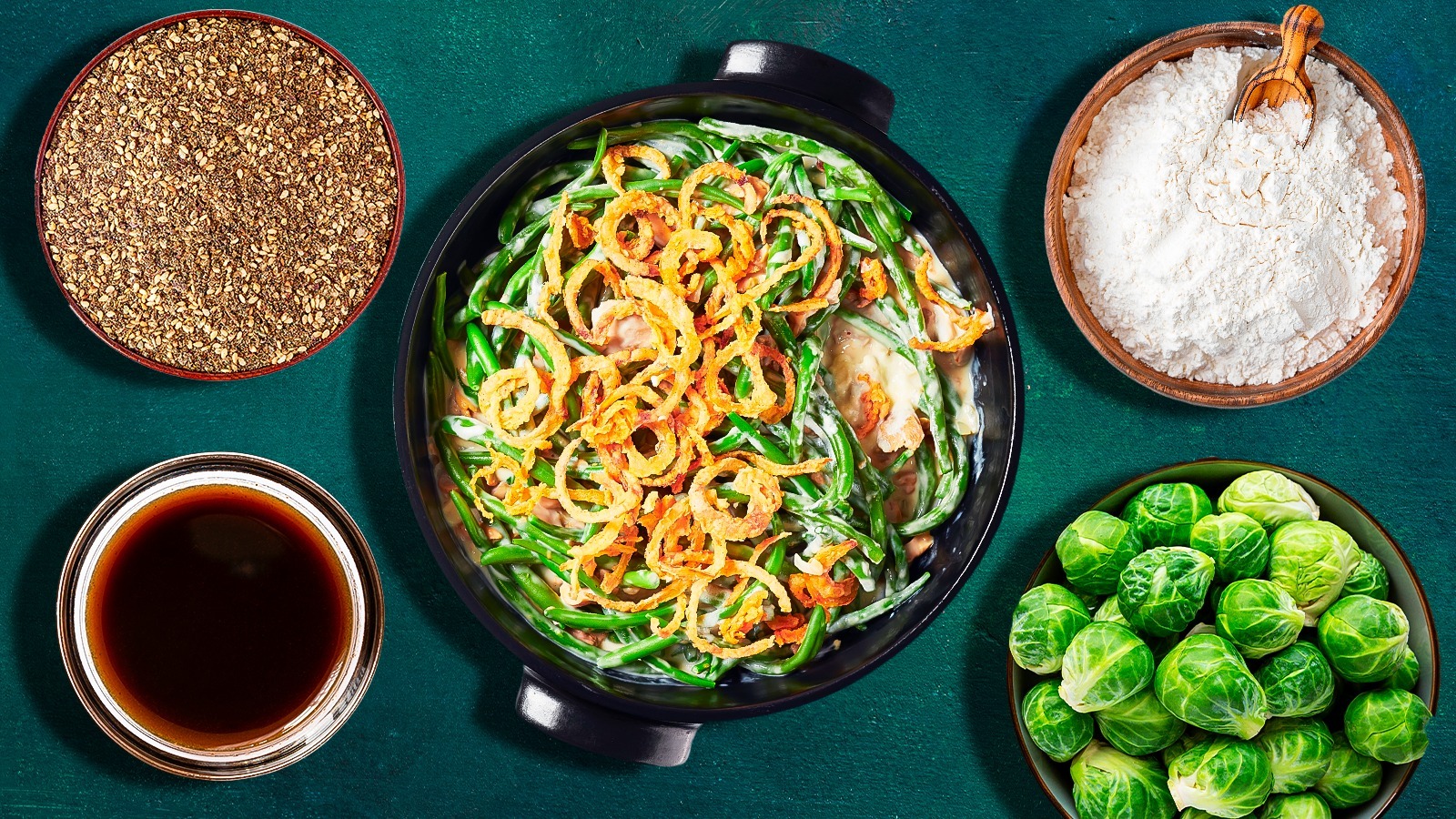Take a moment to visualize your Thanksgiving plate, brimming with a variety of dishes. Amidst the turkey, cranberry sauce, and stuffing, it’s often the side dishes that capture our attention and affection. And, if we’re being entirely honest, it’s probably the green bean casserole that stands out among all the sides.
When this dish was first introduced by the Campbell’s Soup Company in 1955 through the company’s recipe development department, green bean casserole was originally intended to be a fixture for simple weekday menus. Now, it’s taken on a much more prestigious place at the table. A staple of festive feasting, green bean casserole has cemented its place on our holiday menu and in our hearts.
Yet, despite its enduring popularity, there are numerous ways to elevate this beloved dish from a simple side to a crave-worthy, unmissable part of the meal. Whether it’s introducing new ingredients, tweaking the traditional recipe, or incorporating unexpected flavors, even one or two creative adjustments can transform your green bean casserole into something extraordinary. With these innovative ideas, your green bean casserole will never be the same, ensuring it’s not just another dish on the table but a highlight of the feast.
1. Char the green beans
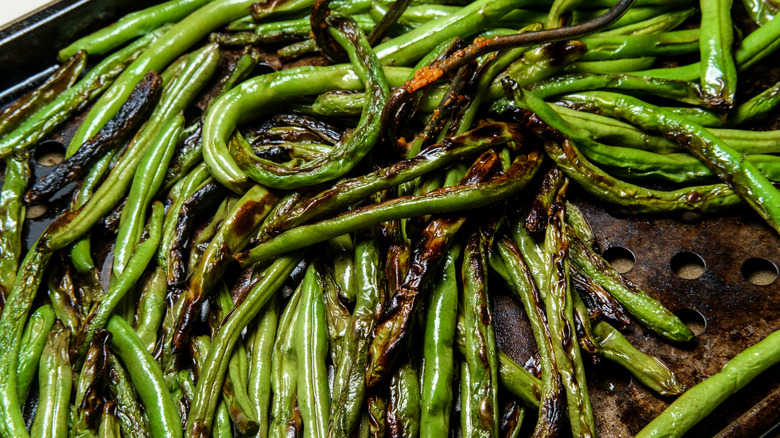
To enhance the flavor of the titular character in this casserole, consider adding charred green beans to the mix. There are a few methods to achieve this, but first, you’ll need your green beans. No pre-preparation is required for frozen beans, but if using fresh beans, ensure they are rinsed, trimmed, and cut before proceeding to the charring process.
Find a sheet pan large enough to hold your beans in a single, flat layer. The simplest way to char the beans is to toss them with a bit of oil and spread them out on a baking sheet before placing them under your broiler. Maintaining a single layer is crucial, as it ensures even charring. Under the broiler, they should take about five minutes; avoid leaving them under the heat for too long. While not mandatory, flipping the beans halfway through is recommended for even charring. Once removed from the oven, handle them as you would uncooked beans.
From here, proceed as usual to complete your delicious casserole, incorporating the charred green beans as you would normally. This step should not affect the overall cooking time, as the rest of the casserole still requires its full cooking duration.
2. Create complexity with za’atar
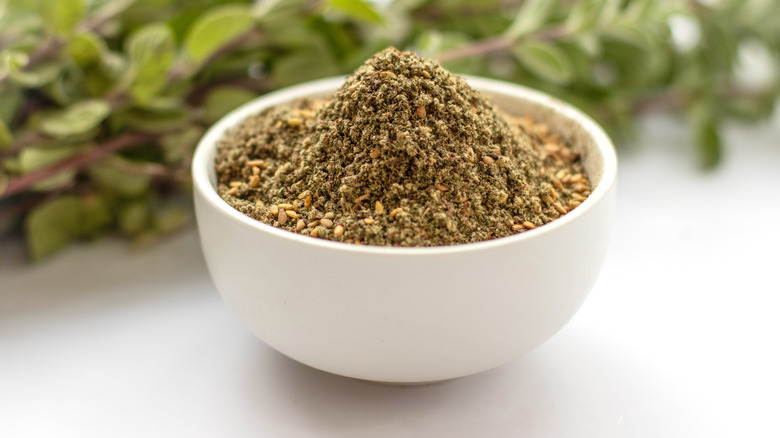
In terms of spices, traditional green bean casseroles typically lack a variety of seasonings. To introduce some complexity to the dish, you can add za’atar to green bean casserole. This Middle Eastern spice blend is derived from the za’atar plant, known scientifically as Origanum syriacum. While finding this exact blend in an American grocery store might be challenging, you’re likely to find alternatives made with thyme or oregano, along with sumac, sesame seeds, and other variations such as dill or even orange zest. Although there’s always a possibility you won’t find this specific spice blend locally, it is readily available on Amazon.
To integrate za’atar into green bean casserole, simply mix it into the cream of mushroom soup used as an ingredient. The quantity required depends on the amount of green beans. For every pound of green beans, use a tablespoon of za’atar. If you desire a more pronounced flavor, feel free to increase the amount, but it’s advisable to start with a 1-to-1 ratio the first time you try this. Should you feel future dishes could benefit from more za’atar, adjust accordingly, but make sure to establish a baseline first.
3. Fix watery casserole with cornstarch
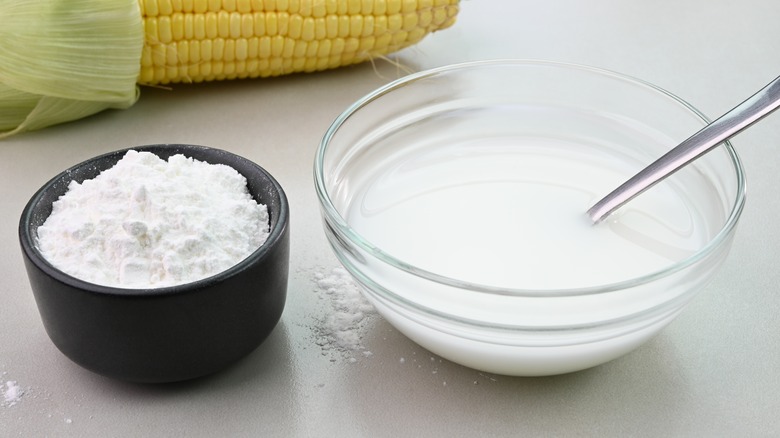
If you’ve ever deviated from your typical green bean casserole recipe, you may have encountered consistency issues that can be understandably frustrating. However, there are ways to fix the consistency, especially if you have a watery green bean casserole on your hands.
While the casserole is still on the stove, mix together cornstarch and water to create a slurry, and stir it into the mixture. If, on the other hand, you’ve removed your casserole from the oven and only then discovered a runny consistency, there’s still time to save it. You’ll need to take a few moments to remove your onion topping, then return the casserole mixture to the pan, add your slurry, and return it to the oven after replacing the topping so that it can get crispy. This will require only a few minutes, so be sure to watch closely to avoid burning. You’re just looking for those onions to get crisp. Although it’s not an ideal solution, it will solve the problem. To avoid this issue to begin with, make sure your fresh veggies are thoroughly cooked before they meet the oven, so water isn’t released from the veggies while cooking.
After adding this slurry, there’s always a chance of a slight flavor change in your casserole. We recommend sampling your casserole as you return it to the dish to see if salt or pepper may need to be added to liven up the flavor with the new addition.
4. Add kick with Worcestershire sauce
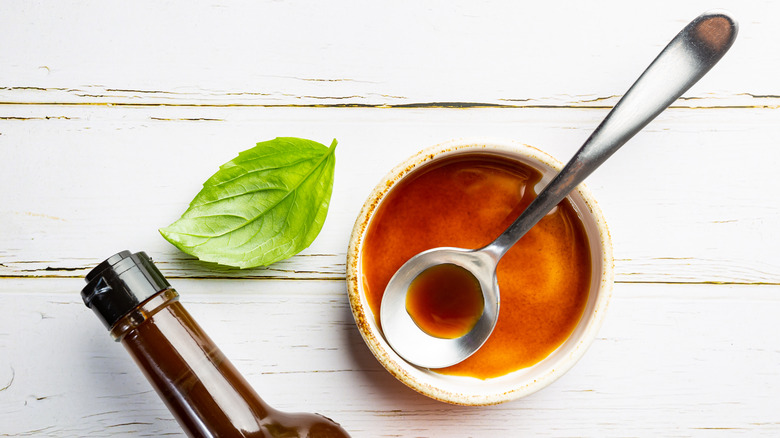
Goskova Tatiana/Shutterstock
Even though homemade green bean casserole is considered a classic, there are still plenty of ways that recipes differ from each other. Many, for example, are simply a mix of soup, green beans, fried onions, salt, and pepper. Other homemade recipes, though, include a condiment we normally reserve for meaty main courses: Worcestershire sauce, the new secret ingredient that will elevate your green bean casserole.
One of the most interesting aspects of Worcestershire sauce is its complex flavor profile. It packs sweetness, acidity, and saltiness, all of which can take your green bean casserole to a whole new level of flavor. One of our favorite parts about this easy way to add a little zip to your casserole is that it’s an additional step that takes nearly no time in the grand scheme of preparing your dish. Simply mix a splash of Worcestershire sauce right in with your cream of mushroom soup, and allow it to combine before mixing the rest of your casserole together. Don’t be afraid to make it a generous splash, but be sure not to go overboard. After all, Worcestershire sauce can be a very powerful flavor.
If you happen to be cooking for a vegetarian crowd, it’s important to note that Worcestershire sauce is typically not vegetarian. However, all hope is not lost, as you can whip up an anchovy-less Worcestershire sauce to use instead.
5. Make it vegan with cauliflower
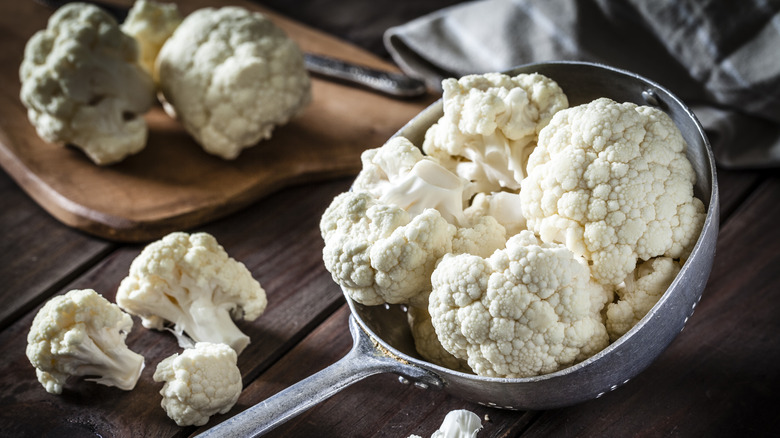
Just because the dish is known as green bean casserole doesn’t mean it’s the only vegetable you can include. In fact, for a vegan green bean casserole that forgoes the traditional recipe’s dairy-heavy base, cauliflower adds additional texture and flavor, making this dish as exciting as the classic version.
This process begins on your stovetop when you cook your cut cauliflower and green beans. While those are cooking, you’ll sauté mushrooms, garlic, and shallot until the alliums are soft and the mushrooms have released a lot of their liquid. Add wine, as well as veggie broth and tahini to introduce some creaminess. If you happen to be a fan of nutritional yeast, and the slightly nutty flavor it provides, this would be a great place to include it as well.
After adding in your veggies and coating everything in the sauce, you’ll pour it into a baking dish and pop it in the oven. This casserole may not be the typical way to make a green bean casserole, but as a vegan offering, it presents the dish in a new way that isn’t just a simple substitution of ingredients. That is, instead of merely using a non-dairy soup base, which can sometimes taste a bit off compared to the original, it creates something wholly new as a casserole alternative.
6. Simplify with homemade cream of mushroom soup
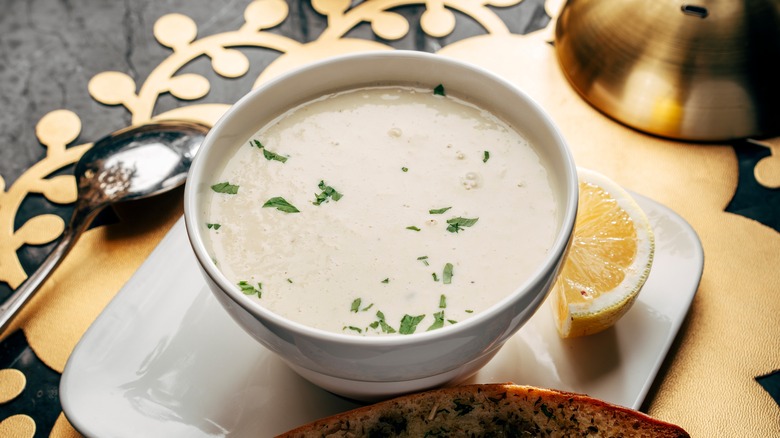
Preparing a green bean casserole often means stirring in a can of cream of mushroom soup for convenience. However, some home cooks may not realize that making your own homemade cream of mushroom soup can enhance the dish, offering an even more homestyle feel to your casserole.
Alton Brown takes green bean casserole to the next level by using his own soup, made by first browning mushrooms before adding half-and-half and flour to thicken the mixture, along with butter and sherry vinegar to enhance the creaminess. Be sure to taste and add some salt and pepper if the mixture needs it. One of the greatest advantages of preparing such ingredients from scratch is the ability to adjust them to your taste.
If you and your family are fond of mushrooms, feel free to enrich your cream of mushroom soup with as many mushrooms, in as many varieties, as you desire. Cooking transcends merely following recipes; it should be an artistic expression, even with something as straightforward as a green bean casserole. Taking the opportunity to craft ingredients from scratch that are typically pre-made fosters an incredibly personalized cooking experience.
7. Swap crispy onions for Ritz crackers

If you’ve ever shopped for ingredients during the bustling holiday season, you know how taxing the experience can be. First, you make your list, which always seems to be missing one or two items, and then you scour the shelves searching for those particular items. Unfortunately, stores often run out of the most popular ingredients, including crispy fried onion rings.
Perhaps the panic is delayed just a bit to your Thanksgiving afternoon, when you go to prepare the green bean casserole only to realize that you, in fact, forgot to get your yearly batch of fried onions. You’re left without a necessary ingredient. While making your fried onions from scratch is certainly a delicious option, for something a little quicker and different, you might want to try Ritz crackers in your green bean casserole.
The swap is a simple one, and if you are sharing appetizers during your Thanksgiving preparations, there’s a good chance you have some Ritz crackers already in your pantry. They’re more of a staple ingredient than fried onions, making this an excellent substitution in an absolute pinch. To use them in a similar fashion that you might with crispy fried onions, you’ll need to break them apart a little, rather than using whole crackers. You can also season them however you’d like, including with pepper, garlic powder, and even onion powder to really try to emulate the flavor of fried onions.
8. Use frozen green beans
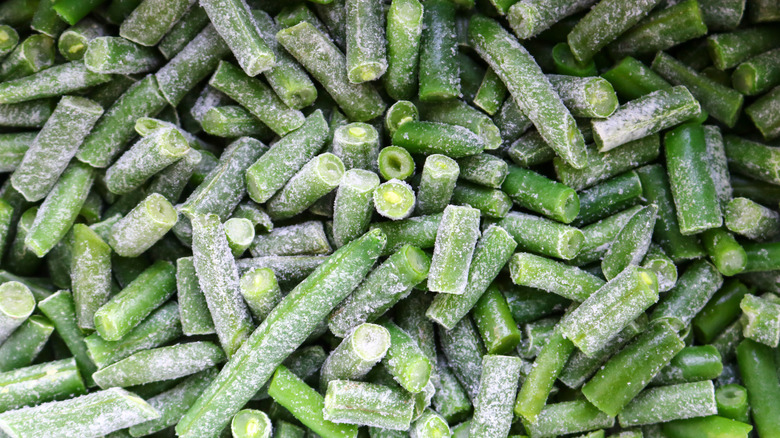
When the original green bean casserole recipe was created, Campbell’s recommended home cooks use frozen vegetables. Today, we use frozen, canned, or even fresh vegetables. Although frozen vegetables sometimes get a bad reputation, they work quite well in the green bean casserole world. The best part is, if you’re really short on time, you can throw them right into the mix without needing to do anything but measure and dump.
In the case of fresh green beans, you need to cook and even trim them to get them to the way you want them to be. Then, there are canned green beans, which can result in an ultra-mushy and even quite salty casserole. In the end, the primary reason why frozen green beans are a better choice for green bean casserole is because they simply create a better side dish for you and your family to enjoy.
Of course, the choice of what type of green beans you would like to use rests entirely with your and your family’s preferences in terms of flavor and consistency. If you have used canned green beans to great success, consider mixing frozen with canned for a little bit of variance.
9. Bake your own onions
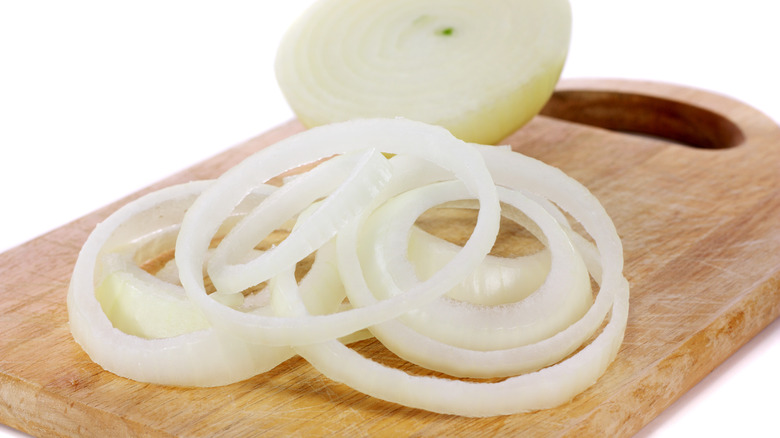
If you enjoy green bean casserole, you’re likely familiar with the delicious onion pieces. These crispy fried onions come in an easy-to-use container, and tend to be well-stocked at stores around the Thanksgiving and winter holiday season. However, if they are in short supply near you, or you prefer a less fried route, trying baked onions may be the perfect solution for a more healthy green bean casserole recipe.
The good news is that this ingredient is easy to make on your own. You’ll begin by slicing up onions, then tossing them in flour, salt, and breadcrumbs with some oil to make sure they are fully coated and all the ingredients are combined. For an extra unique flavor, you could also add some garlic powder, paprika, or even cayenne to add extra heat to your green bean casserole, a flavor not frequently found in this dish, but perfect for families that desire it.
These coated onions will end up on a baking sheet before you’ll pop them in the oven, allowing the onions to achieve that ideal golden color. After they’ve spent some time cooling, you can use them in all the same ways you would use typical crispy fried onions by integrating them into your casserole and using them as the topping. By baking them in this way, you’re adding another layer of homemade quality to your casserole and eliminating an aspect that is processed and fried, a major benefit to many.
10. Wait to add onions
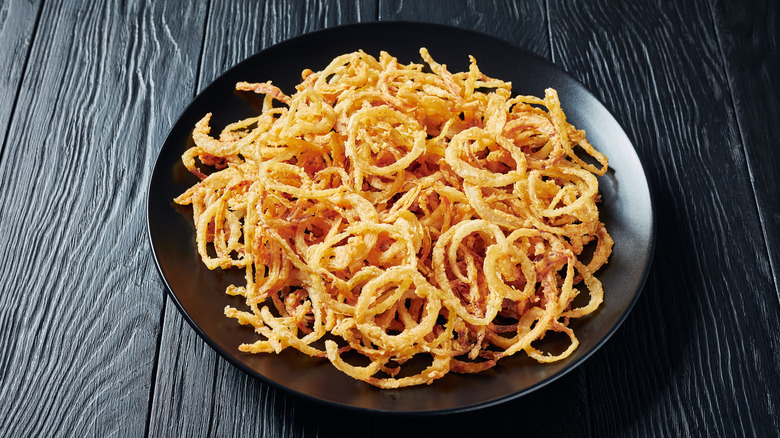
Along with enjoying delicious side dishes, another part of large meals that we love is reheating leftovers — and thankfully, there are many side dishes that reheat incredibly well. Unfortunately, green bean casserole isn’t one of them, especially when it comes to the crispy onions on top.
However, this is easily remedied by keeping more crispy onions on hand to sprinkle on at a moment’s notice. Alternatively, if you are making casseroles ahead of time in preparation for the holiday, and looking to save a little time, refrain from adding those crispy onions as a final step until you are ready to serve. By waiting to include the onions until after the casserole has thawed out and is ready for serving, you’re guaranteeing a better crunch from your crispy onions that will grace the top. This small step in holding the onions until the very end helps make even a pre-made casserole feel freshly produced with that extra bit of crunch on top.
If you happen to forget to temporarily hold the onions, you can still save that crispiness on top by popping your leftovers underneath your oven broiler for a few minutes to add a little bit of extra toasty quality to it. It may not create the same effect as freshly added crispy fried onions, but it’ll get you closer than soggy onions.
11. Add another veggie with Brussels sprouts
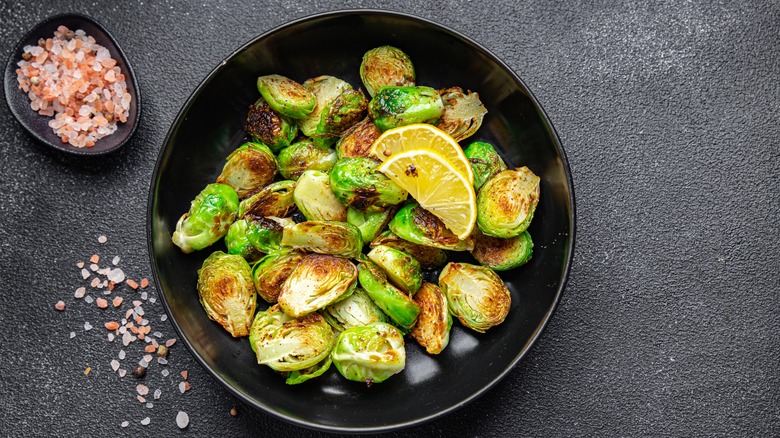
If you or your family are getting tired of green beans or want another vegetable to complement them in the dish, consider including roasted Brussels sprouts in your green bean casserole. Although we don’t necessarily recommend replacing your green beans entirely with Brussels sprouts, as that would remove the green bean aspect from the green bean casserole altogether, adding Brussels sprouts as another flavor and vegetable in the mix could be a delicious and unique addition, and an unexpected surprise at the dinner table.
Roasted Brussels sprouts are ultra-easy to make. You’ll begin by using fresh Brussels sprouts, splitting them in half, and then drizzling them with oil, seasoning them in whatever manner you see fit, and spreading them across a baking sheet. Cook them until they are tender but not fully done, as they’ll continue cooking as part of your casserole. You can either mix them right in with your green beans or layer them in your dish. We recommend giving both methods a try to determine what your family prefers both in terms of the vegetables’ tenderness and overall flavor.



